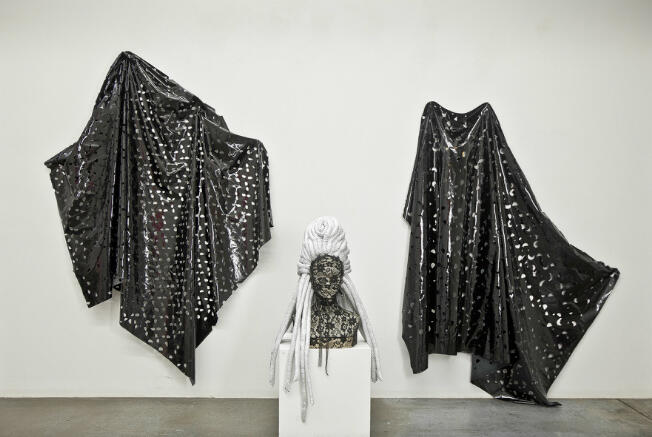Clemencia Labin
Diana Lowenstein, Miami
The works of Venezuelan artist Clemencia Labin (Maracaibo, 1946), who has lived in Germany for over 20 years, maintain strong links with her home town, as well as references from it, both concerning the thematic and the formal aspects, in spite of the distance and the time gone by since she left it.

Labin has recently held the exhibition “La mantuana” at Galería Diana Lowenstein, in which she showed ten pieces − collages, installations, assemblages and a documentary video that records her performance for the past edition of the Venice Biennial. The artist works easily with a myriad materials and media: paintings, assemblages, collages and murals, and installations. Besides, in the past few years it has been possible to observe a formal step by which without moving away from abstraction, she has incorporated local figures and themes in her pieces.
Labin’s “La mantuana” − a name derived from the mantillas worn by Spanish women − gathers together installations of dummies and fabrics that evoke the colonial Venezuelan past. She exhibited some of her individual “Pulpas”, volumes made in brightly colored lycra used for manufacturing bikinis, in the manner of carnal, opulent and voluptuous paintings. For some years now she has been developing these pieces, which connect mostly with a more formal than historic theme related to pop, as the artist herself has expressed. In the piece that gives its title to the exhibition, the torso of a dummy covered with a turban constructed in the manner of her “pulpas” –armed with stuffed fabrics − is centered between two mantillas made of a die-cut patent leather fabric and a bench acting as a shoehorn.
Labin, who in the past had identified herself with the palette and the emotions of her homeland, now inquires into the history of her town, and incorporates not only her previous formal concerns, but also themes intimately related to the history and tradition of Maracaibo and Venezuela. Mantuanos is the name given to those who, although being children of the Spaniards from the colony, had been born in the new world, and their identity is interwoven with the local aristocrats that enjoyed many social and political privileges, and were precisely the initiators of the process of independence of Venezuela from the motherland.
One of the most relevant aspects of Labin’s work is the collective art project that she has been organizing and directing for the past eleven years: the Night of Santa Lucía, which consists in a week of interventions by a group of artists and curators in homes of the historic quarter of the town center – based on an announcement open to all, as long as they perform their work/intervention in that place. This project is circumscribed to the activity and social life of that community, in which the neighbors open the doors of their homes to receive hundreds of artists from all over the world; it works as an experimental platform, where they have the chance of producing a site-specific work in a joint way with a community and it highlights the need of artists as social beings.
-
 La Mantuana, 2011. Mixed Media. Installation of variable dimensions/Técnica mixta. Instalación de dimensiones variables. Photo Courtesy/Foto cortesía: Diana Lowenstein Fine Arts Gallery.
La Mantuana, 2011. Mixed Media. Installation of variable dimensions/Técnica mixta. Instalación de dimensiones variables. Photo Courtesy/Foto cortesía: Diana Lowenstein Fine Arts Gallery.




